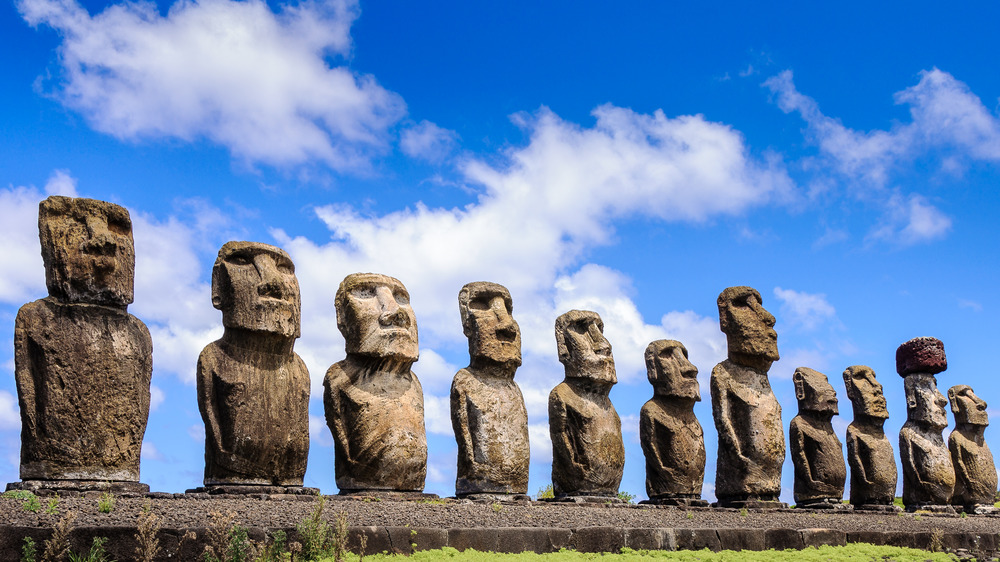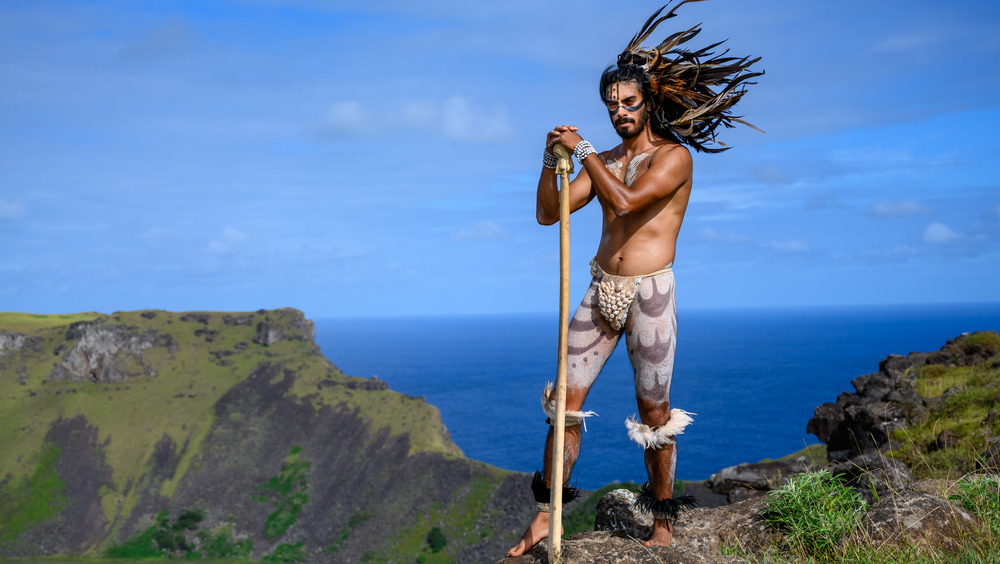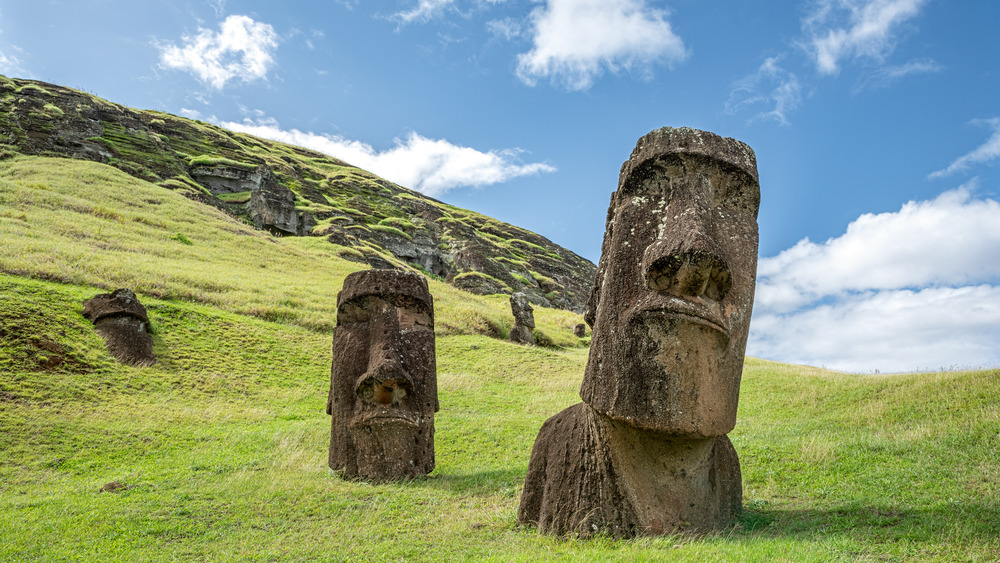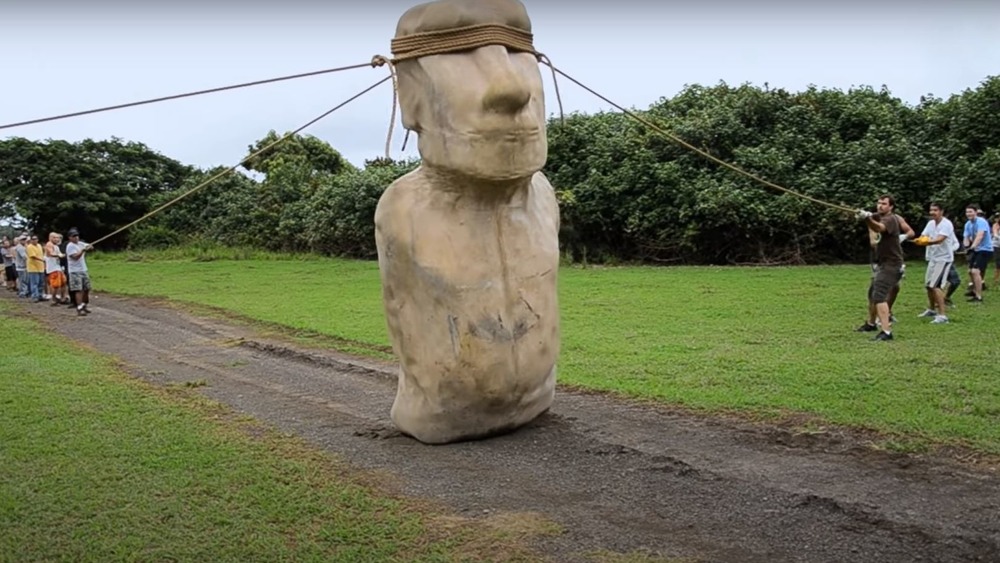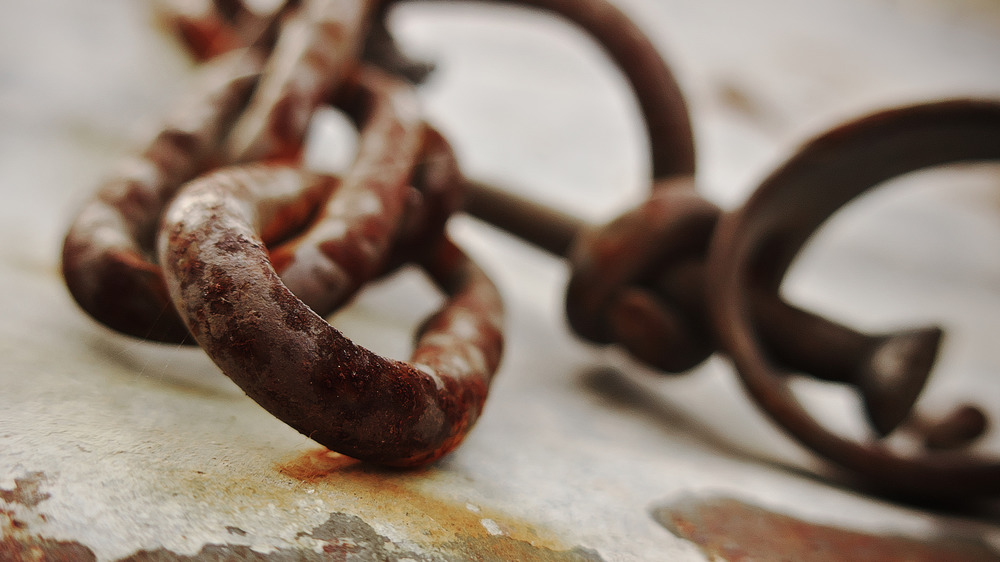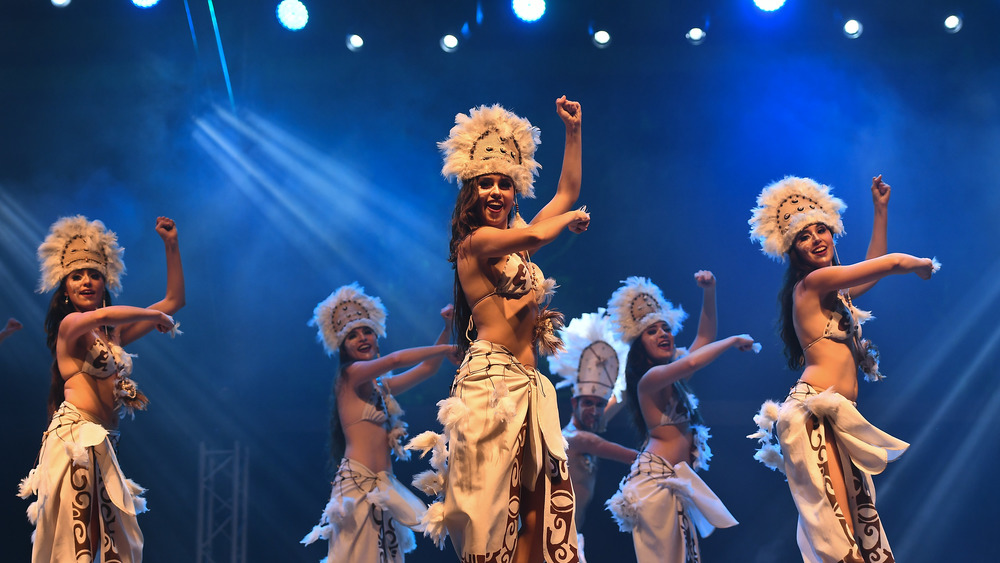The Untold Truth Of Easter Island
Rapa Nui, or "Easter Island" as it was called by Dutch explorer Jacob Roggeveen, is a small, 63-square-mile island at the southeast tip of what is referred to as the Polynesian triangle (Hawaii is at the northernmost tip, and Aotearoa — New Zealand — in the southwest). The size of the island, with its rocky coasts shorn yet green hilltops, belies the size of its complex history and home as one of archeology's largest, most enduring mysteries: the moai, its standout feature that most know as "those big head statues."
When Roggeveen landed on Rapa Nui on April 5, 1722 (Easter Sunday — hence the name), he caught a mere glimpse of what he hoped was "the unknown Southern continent" (what we now call Australia), as South American Vacations tells us. His description of a native Rapa Nui was predictably colonial and not too flattering, "He was quite nude, without the slightest covering for that which modesty shrinks from revealing. This hapless creature seemed to be very glad to behold us, and showed the greatest wonder at the build of our ship."
Of course, Rapa Nui had been inhabited for at least 900 years at that point, as History explains. The descendants of an initial Polynesian landing party (possibly from the Marquesa Islands) had developed their own language, culture, and of course, the renowned moai megaliths — 887 of them, in fact — all while 1,200 miles away from their closest island neighbor, Pitcairn Island.
Ancient Polynesian people visited by Europeans
At the time that Roggeveen arrived, there were about 2,000 – 3,000 people living on Rapa Nui, which was believed to be on the downside of a once much larger number of people, possibly upward of 17,500 people, as Bright Side recounts. There were no domesticated animals on the island, although the native inhabitants had a robust agriculture reliant on sweet potatoes, as Britannica explains. Besides this, islanders relied heavily on fishing, and used the island's trees to make boats to navigate the surrounding area.
Per the Sacred Land Project, not much is known about the early Rapa Nui inhabitants aside from the name of their home — Te Pito o te Henua, or "The Navel of the World" (similar to the Greek "omphalos") — as they relied on oral stories. Eventually, Rapa Nui was visited by Englishman Captain James Cook in 1774, who described a civilization on decline of less than 1,000, followed by 1786 French navigator Jean-François de Galaup. Peruvians in the 1860s, who began a slave trade in a time of smallpox, reduced the islander population to less than 100.
Currently, Rapa Nui is a territory of Chile, which, in May 2019, declared the island in a state of "latency," indicating that it was "on the edge of environmental collapse and demographic saturation." There are now 7,500 inhabitants on the island, 60 percent of which are indigenous, per the International Work Group for Indigenous Affairs.
The ongoing moai mystery
For many, the big highlight of Rapa Nui is, of course, its moai. They ring the island in the hundreds, all of them facing inland except for a mere seven statues at a holy site called Aku Akivi, which as Imagine Isla de Pascua describes, is a site for viewing astronomical phenomena such as solstices and is based on a tale of the original seven explorers sent by King Hotu Matu'a to find Rapa Nui after he had a vision of the island. The rest of the statues? No one really knows, although it's generally believed that they were considered guardians of the island, as they face inward in a seemingly protective ring.
The moai, as The Travel explains, weigh about 90 tons each and are 33 feet tall. Each one has unique features, and all seem to have been built from the 14th to 15th centuries. Their construction and movement to their current positions have been the subject of countless debates and theories that even extend to extraterrestrial involvement and levitation to move the statues, as this YouTube clip from the History Channel's infamous Ancient Aliens depicts.
Later evidence shows that the moai, composed of "tuff," or compressed volcanic ash from the nearby volcano Rano Raraku, were subjected to vandalism. Some even had their eyes poked out. Only as recently as 2012, per Live Science, was it discovered that the moai are not mere heads but have bodies extending into the ground.
New answers to centuries-old questions
It was once assumed that the Rapa Nui people rolled the moai into place using wooden logs cut from the island's once 16 million trees, as numbered by NPR. The problem in that case, of course, was how the moai were lifted up onto their ahu (platforms), and how they had their pukao (petrogylph-inscribed hats) put on. The pukao mystery was easier to solve, as a 2018 Science Alert article describes. Using a "ramp-and-ropes" pulley technique called parbuckling, the islanders simply pulled the pukao up a ramp and on top of the moai.
As for how the moai were transported, researchers used to believe that their transportation was linked to Rapa Nui's current deforestation, as the islanders must have engaged in a "slash and burn" agricultural technique that involved clearing paths for the moai to be rolled across the island. Realistically, though, this simply doesn't make sense, as the island was self-sustaining for centuries, and the islanders more than well-accustomed to its ecology.
A 2012 article in the Journal of Archaeological Science, cited by Scientific American, depicts a brilliant, alternative, all-but-proven answer. Based on evidence put forth in an earlier book by archaeologists Lipo and Terry Hunt, The Statues That Walked, the moai were "walked" toward their destinations by being rocked back and forth, like if you had to move a refrigerator by yourself. And funny enough? Rapa Nui lore states that the statues "walked" to their current resting places.
An interrupted civilization: slave trade and ecological change
For decades, scholars haven't been able to agree on the cause of the decline of Rapa Nui's natural environment and people. We know that the island underwent widespread ecological change, typically believed to be man-made and also related to the moai's construction. The Rapa Nui, though, had been able to cultivate the island with sweet potatoes as far back as 1400 CE, and as the 2007 book Rethinking Agriculture: Archaeological and Ethnoarchaeological Perspectives (cited on Research Gate) describes, islanders were adept enough to even use the island's volcanic detritus — called lithic mulch — to fertilize their crops during drier months. It's more likely that they survived despite ecological change. This perspective is shared by professor of Anthropology at Virginia Commonwealth University Christopher Stevenson, who believed that Rapa Nui's environment had been undergoing a continual, natural decline long before any outside contact (cited on PNAS).
As for demographic decline, we know that Rapa Nui was used for slave trade in the 1860s, as previously mentioned, and the islanders were subjected to typical, abominable colonial violence. But despite this, and the introduction of European-borne microbes into the island's ecosystem, recent 2020 research indicates that this kind of cultural interference did not actually cause Rapa Nui to collapse (per Science Daily). This research shows that there was no societal collapse, either before or after Jacob Roggeveen arrived in 1722. The islanders merely managed to preserve their heritage despite obstructive extrinsic factors.
A modern-day tourist hotspot and territory of Chile
At present, it might be tempting to envision Easter Island as an abandoned relic of civilization. In reality, as seen on Lonely Planet, you can go and book a plane ticket today to Mataveri International Airport on Rapa Nui, stay at Hanga Roa, the island's main town, book a tour, catch a show, you name it. It's less than a six-hour flight from Santiago, Chile, and, as The World tells us, typically gets 60,000 visitors a year. Locals largely speak Spanish, but schools teach the native Rapa Nui language, a Polynesian derivative, and islanders are doing their best to preserve traditional music and dance.
Strangely enough, part of the continued strength of Rapa Nui culture derives from an 18th-century "birdman cult" that arose on Rapa Nui to honor the creator god Make Make (analogized to a bird). Islanders would compete in a cliff-climbing, shark-water-swimming race to fetch the year's first egg laid by birds at a small island off the shore, as Imagine Isla de Pascua describes. Then there's the Tapati Rapa Nui Festival, which as Culture Trip describes, started in the 1970s as a way to preserve culture. It includes the daring and slightly crazy Haka Pei, a sporting event in which participants slide down a steep, 300-meter (1,000-foot) slope descending from the top of a volcano on a banana tree sled wearing only a loincloth.
Visitors can join the fun, too, and along the way, even check out some moai.
